|
What is iaido?
History
Technique
Study process
Grading and competitions
Necessary equipment
What is iaido?
Iaido is the art of drawing the sword from its scabbard and using it to fend off an attack. It is one of Japanese martial arts that probably has the largest amount of misconceptions regarding it. Some see it as an archaic and rather useless system of fencing, others tend to use it as a kind of moving meditation. Iaido can be all that and more.
Historically speaking, the role of iaido's predecessor, iaijutsu, in a warrior's training was twofold: first, it gave him the opportunity to train with a real sword (shinken) without worrying about fatally injuring the partner or, worse still, the teacher; and second, it introduced the techniques useful when one had to attack or defend oneself without a chance to draw the sword out of its scabbard beforehand. Thus iaido was more of an auxiliary discipline to kenjutsu, or fencing proper.
Nowadays swordsmanship is not a practical skill anymore (unless one is willing to take the “Highlander” stories seriously) and it became an art practiced by a relatively small group of enthusiasts of this kind of pastime. Some among them put more focus on studying the practical skills of drawing the sword efficiently (they prefer to call their art iaijutsu or battojutsu). Others prefer to treat it as a way of self-improvement through better control and understanding of their body and the sword for them is primarily an instrument to attain this goal. Iaido by itself allows for both of these approaches and each practicioner is free to decide what's best for them.
The word “iaido” itself appeared in the 1930-s and was popularized by the famous swordsman Nakayama Hakudo. There are, however, many different names that have been used for the art of sword drawing, most of them using the characters  — “batsu/nuku” (“to pull out”) and — “batsu/nuku” (“to pull out”) and  — “to/katana” or — “to/katana” or  — “ken/tsurugi” (both meaning “sword”). Even Nakayama himself was originally using the characters “batto” (“sword drawing”) with an indication that they should be read as “iai”. — “ken/tsurugi” (both meaning “sword”). Even Nakayama himself was originally using the characters “batto” (“sword drawing”) with an indication that they should be read as “iai”.
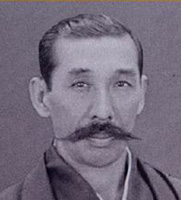
Nakayama Hakudo
Ideographic analysis doesn't really help us understand the meaning of the word “iaido” (   ). In addition to the character ). In addition to the character  — “do” (“way”) it contains the characters — “do” (“way”) it contains the characters  — “iru” (“to be”) and — “iru” (“to be”) and  — “ai” (“meet, combine”, often translated as “harmony”), which seems to translate as something like “the way of attaining (or existing in) harmony”. But in reality the first two characters are taken from the phrase “tsune-ni ite kyu-ni awasu” (“ite” is a form of the verb “iru”, and “awasu” is the verb formed from the character “ai”), which can be translated as “wherever you are you always have to [be ready to] act immediately”. — “ai” (“meet, combine”, often translated as “harmony”), which seems to translate as something like “the way of attaining (or existing in) harmony”. But in reality the first two characters are taken from the phrase “tsune-ni ite kyu-ni awasu” (“ite” is a form of the verb “iru”, and “awasu” is the verb formed from the character “ai”), which can be translated as “wherever you are you always have to [be ready to] act immediately”.
History
Iai as an independent art separate from kenjutsu is due to Hayashizaki Shigenobu who lived at the end of the Warring States period and the beginning of the peaceful Tokugawa era. The quick draw techniques that he designed became so popular that many people were coming to learn from him and he is often referred to as the founder of iai.
One of the styles that traces its origins from Hayashizaki even though it had been extended with additional techniques, survived for a long time in the province of Tosa (present-day Kochi prefecture) on Shikoku, but at the beginning of the 20-th century became practiced beyond its borders. Oe Masamichi and Nakayama Hakudo, masters from two different branches of Tosa iai and founders of the modern Muso Jikiden Eishin-ryu and Muso Shinden-ryu, managed to uphold the interest for iaido when the whole country was turning to embrace the Western culture.
After the World War II the All-Japan Kendo Federation was organized and its governing body decided that it will be useful for its members to study the techniques and mechanics of using the real sword and not just the safe (and therefore lightweight and mobile) imitation that is the shinai used in full-contact kendo. However, it was impossible either to select a single classical style or to set up standards for all styles and it was decided to create a set of techniques that would satisfy all the requirements. Masters from different styles were invited to work on this set, primarily those from the Muso shinden-ryu and Muso Jikiden Eishin-ryu, many of whom were direct students of Oe and Nakayama. The set they created, known as Zen Nihon Kendo Renmei iaido (iaido of the All-Japan Kendo Federation), or, unofficially, as seitei iaido (standard iaido), was first introduced in 1969 and soon became the most widely practiced style of iaido. After having gone through two big modifications in 1977 and 2001 and a number of small ones almost every year, this is the set that is studied at “Eishinkai”.
Classical styles (koryu), however, have not disappeared, and seitei is regarded by many as the first step towards their study. Thanks to the efforts of Ide Katsuhiko-sensei the most widespread koryu in Russia is Muso Shinden-ryu. At “Eishinkai” we practice the Muso Jikiden Eishin-ryu of Oshita Masakazu-sensei, however, only advanced students who have had enough experience with seitei iaido are allowed to train in this style.
Technique
As the basis of iaido is the technique of sword-drawing, all the kata start with the sword in its scabbard and consist of pre-arranged patterns of actions in different circumstances. The first move is almost always drawing the sword out and continuing into a one-handed slash (then it is usually called nukitsuke) or a parry (ukenagashi) if one is necessary. It is followed by one or several (depending on the number of opponents in a given scenario) slashing cuts or thrusts, and the kata ends with ritual “shaking off the blood” (chiburi, or chiburui) and returning the blade to the scabbard (noto). Some kata contain more specific actions such as striking with the pommel or supporting the blade with the free hand for a more efficient thrust at close range. In koryu the technical variety is still bigger but most of the complicated techniques are introduced on higher levels.
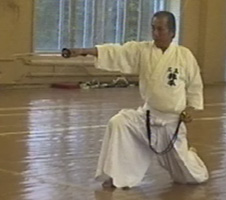 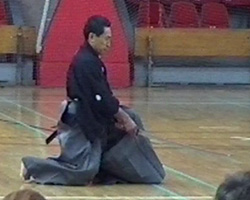
Nukitsuke by Ide Katsuhiko-sensei and kiriotoshi by Inoue Katsuhiko-sensei
In seitei iaido speed is not considered an important factor thus there are few kata in which the situation requires drawing the sword quickly. What is underscored, are precise cuts (especially cutting angles and points of stopping the cuts), as well as the notion of jo-ha-kyu, which means speeding up gradually for each cut. It doesn't matter whether a kata is performed at high or low speed, this speeding up has to be present.
Zen Nihon Kendo Renmei iaido kata contain the following techniques:
| 1 | (ipponme) | — | Mae (“front”) |
| 2 | (nihonme) | — | Ushiro (“back”) |
| 3 | (sanbonme) | — | Ukenagashi (“parrying block”) |
| 4 | (yonhonme) | — | Tsukaate (“pommel strike”) |
| 5 | (gohonme) | — | Kesagiri (“diagonal slash”) |
| 6 | (ropponme) | — | Morotezuki (“two-handed thrust”) |
| 7 | (nanahonme) | — | Sanpogiri (“three-directional slash”) |
| 8 | (hachihonme) | — | Ganmenate (“strike to the face”) |
| 9 | (kyuhonme) | — | Soetezuki (“thrusting with hand support”) |
| 10 | (juponme) | — | Shihogiri (“four-directional slash”) |
| 11 | (juipponme) | — | Sogiri (“complete slashes”) |
| 12 | (junihonme) | — | Nukiuchi (“draw and cut”) |
Study process
Learning iaido is almost exclusively learning the kata. At the first stage much attention is paid to practicing the basics (kihon): nuki tsuke, vertical slashes (kiri otoshi, or kiri oroshi), various types of chiburi and noto, that are found throughout the kata, as well as their combinations. Almost at the beginning one will also start learning the first kata Mae, which not only contains all the basic elements, but also helps to focus on using a number of relevant muscles while minimizing opportunities for using the wrong ones. Gradually, the focus shifts from kihon to kata and the basics continue to be practiced as parts of the complex techniques.
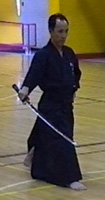 
Chiburi by Oshita Masakazu-sensei and noto by Eto Eiko-sensei
In iaido there are almost no paired kata (if one doesn't count the less-known koryu sets) and no free sparring similar to randori in judo or jigeiko in kendo. Without practicing with a partner it's very difficult to understand such important notions as hyoshi (rhythm), maai (distance) and sen (initiative), therefore iaido practitioners are encouraged to practice kendo or study the paired kendo-no kata, as well as to study jodo.
Grading and competitions
The All-Japan Kendo Federation has adopted the system of ranking (dan'i), based on the ranks of higher (dan) and lower (kyu) series, analogous to ranks in other Japanese arts (not only martial arts). The same system of 8 dan degrees and special instructor licences (shogo) is used in kendo, iaido, and jodo, but ranks in each of these arts are awarded separately.
In the Russian Kendo Federation formal grading is now held starting with the 4th (lowest) kyu. During grading the candidate has to perform 5 kata (3 for 4th kyu), either of his own choice or prescribed by the grading committee and he has to do it within the 6 minute time limit (this limit is only taken into account for dan gradings). This requirement is the same for all ranks, but the level of understanding that has to be demonstrated for passing the examination must, naturally, increase. Besides, all candidates for dan ranks must take a written test with questions covering aspects of iaido history, philosophy and theorety.
Having been awarded a kyu rank one can challenge the next one and after the first (highest) kyu — the first dan and so on, but one must observe the time in rank requirement between gradings. The waiting period increases for higher grades. After reaching 6th dan, one might receive the title of renshi which is the first of the three instructor licences. Requirements for these titles include not only a better understanding of technique, but also the ability to teach. 8th dan hanshi is presently the highest rank (theoretically) attainable.
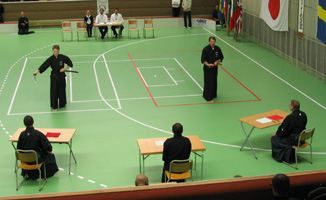
A view of the competition area
There is another way of testing one's skills at iaido, especially in a stressful environment,— competitions. Iaido competition is conducted in the form of engi, i. e. each match has two “opponents” simultaneously perform the kata required (as for grading), while the three judges are comparing their level of skill, raising the flag for the winning side at the end of the match. Certain mistakes, such as going beyond the time limit, stepping outside of the court (if there is one) or performing a wrong kata, lead to an imminent loss.
Iaido competitions have already become regular events in Japan, the USA and Europe. The 8th European Iaido Championships was the first where a Russian team was present. Within Russia there have been organized several regional and interregional iaido tournaments.
Necessary equipment
Iaido practice requires a significant investment of money, which is spent first and foremost on training equipment. Therefore it is advisable to select it carefully, as good equipment will serve longer. For the first couple of sessions any loose closing is allowed, but for continued practice correct clothing is required. It consists of an uwagi, or kendogi jacket, wide pleated hakama pants, and a long and wide obi belt. Also required will be a practice sword. Even though it is possible to get the very basics of iaido using only a wooden sword (bokken), it is strongly recommended to obtain a special alloy sword, iaito, or mogito, as soon as possible.
If necessary, the club can offer practice equipment for the first practice sessions, as well as assistance with finding and choosing a suitable iaito (more information on the choice of equipment and a list of recommended suppliers can be found on our Equipment page, which is only available in Russian).
|